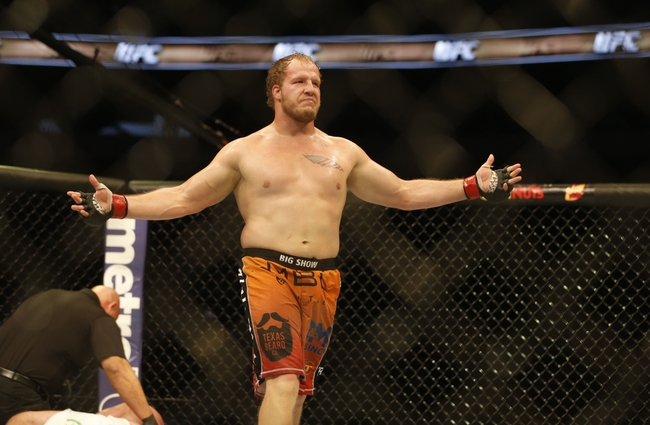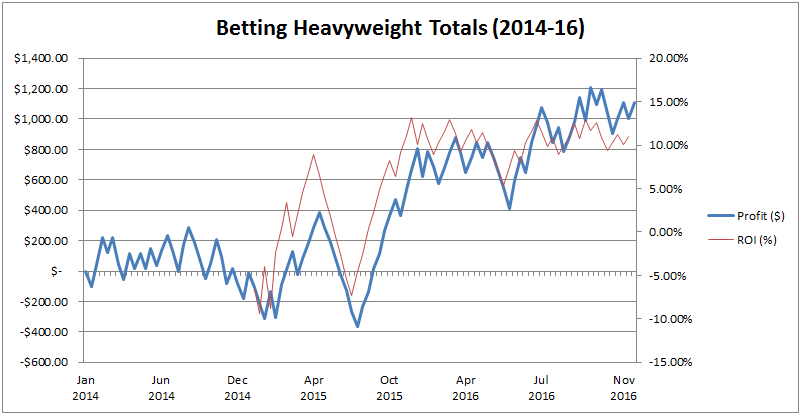 If you listen to The MMA Analysis, follow me on twitter(@bradtaschuk), or even read the opening odds articles prior to each UFC event, you may have seen the hashtag #FGF, or heard the term “Fatties Gonna Fatty”. For those who don’t know, this term refers to the concept that heavyweight fights are more prone than commonly accepted to bogging down. It proposes that rather than the quick knockouts we often associate with the big men in MMA, those contests are more likely to turn into a heaving mass of humanity. Not only that, but it suggests that the best approach to these fights in multiple senses is to break with commonly accepted wisdom and bet that they will drag out. This serves two purposes. One, money. Two, it turns sometimes dreadful heavyweight fights into a win-win situation. Either a stoppage happens in the first seven-and-a-half minutes (where the overwhelming majority of heavyweight totals are set), which is a generally entertaining, desired result; or the fight goes over that seven-and-a-half minute mark, and there’s money to be made. It’s a rather ingenious construct, if I do say so myself. Like many of the things I do or say, this is somewhat jestful and designed to entertain. However, given the amount of life the concept has taken on, it’s time to see how it holds up in practice. Is ‘Fatties Gonna Fatty’ real, as I claim in The MMA Analysis intro, or simply a goofy idea some guy on one of the innumerable MMA podcasts out there came up with? It’s time to find out, and reputations are on the line! First, let’s gather our sample. I joined The MMA Analysis near the beginning of 2014, and began consistently looking at totals in heavyweight fights with the likes of Jared Rosholt (the patron saint of #FGF), Roy Nelson and Ruslan Magomedov throughout that year. This idea expanded throughout 2015, as I thought I picked up on a trend of lower-level heavyweights often struggling to find quick finishes in their early UFC bouts. Finally, 2016 saw the full blossoming of the concept of #FGF. By that I mean I simply disregarded almost all logic and began to look at how every heavyweight fight could go over its lined total. All of that is a roundabout way of saying that I compiled the results of each heavyweight bout in the UFC since 2014 to examine how totals were graded. The number of heavyweight contests during that span has been a relatively small 101 (40 in 2016, 29 in 2015 and 32 in 2014). That lack of sample also necessitated expanding the data to a period before this idea ever really existed. Those 101 fights will serve as the base sample for the remainder of this examination. Of those 101, a whopping 92 were lined with a total of 1.5 rounds (meaning that 2:30 into the second round is the determining point of the bet). The remaining nine lines were all 2.5 rounds. The frequency of fights going over or under their totals has been relatively even, as 53 of 101 have gone over, with the other 48 going under. However, that has not necessarily translated to betting results being equally flat. As a result of the perception that bigger fighters equate to quicker finishes, it was commonplace for an Over 1.5 bet to have plus-money attached to it. In fact, overs were favored just 12 times in 2014 and 11 times in 2015. Oddsmakers seemed to have made an adjustment in 2016, however, as out of the 40 heavyweight bouts this calendar year, overs have been favored 20 times, with two additional bouts a pick em on the total line. The average odds to bet an over in a heavyweight fight also reflect this trend. In 2014, an over paid +120 (bet $100 to win $120). This declined to +112 in 2015, and with just one heavyweight bout scheduled for the remainder of 2016 the number has come down even further to +106. This 14-cent change may not seem like a particularly large amount, but it represents slightly more than a three percent change in probability, which is akin to making an investment with a three percent higher management fee. How has this all translated to dollars and cents? Quite favorably, actually. The chart below shows the results of placing a $100 bet on each heavyweight over from the beginning of 2014 through to the present, in both dollars and return on investment (ROI):
If you listen to The MMA Analysis, follow me on twitter(@bradtaschuk), or even read the opening odds articles prior to each UFC event, you may have seen the hashtag #FGF, or heard the term “Fatties Gonna Fatty”. For those who don’t know, this term refers to the concept that heavyweight fights are more prone than commonly accepted to bogging down. It proposes that rather than the quick knockouts we often associate with the big men in MMA, those contests are more likely to turn into a heaving mass of humanity. Not only that, but it suggests that the best approach to these fights in multiple senses is to break with commonly accepted wisdom and bet that they will drag out. This serves two purposes. One, money. Two, it turns sometimes dreadful heavyweight fights into a win-win situation. Either a stoppage happens in the first seven-and-a-half minutes (where the overwhelming majority of heavyweight totals are set), which is a generally entertaining, desired result; or the fight goes over that seven-and-a-half minute mark, and there’s money to be made. It’s a rather ingenious construct, if I do say so myself. Like many of the things I do or say, this is somewhat jestful and designed to entertain. However, given the amount of life the concept has taken on, it’s time to see how it holds up in practice. Is ‘Fatties Gonna Fatty’ real, as I claim in The MMA Analysis intro, or simply a goofy idea some guy on one of the innumerable MMA podcasts out there came up with? It’s time to find out, and reputations are on the line! First, let’s gather our sample. I joined The MMA Analysis near the beginning of 2014, and began consistently looking at totals in heavyweight fights with the likes of Jared Rosholt (the patron saint of #FGF), Roy Nelson and Ruslan Magomedov throughout that year. This idea expanded throughout 2015, as I thought I picked up on a trend of lower-level heavyweights often struggling to find quick finishes in their early UFC bouts. Finally, 2016 saw the full blossoming of the concept of #FGF. By that I mean I simply disregarded almost all logic and began to look at how every heavyweight fight could go over its lined total. All of that is a roundabout way of saying that I compiled the results of each heavyweight bout in the UFC since 2014 to examine how totals were graded. The number of heavyweight contests during that span has been a relatively small 101 (40 in 2016, 29 in 2015 and 32 in 2014). That lack of sample also necessitated expanding the data to a period before this idea ever really existed. Those 101 fights will serve as the base sample for the remainder of this examination. Of those 101, a whopping 92 were lined with a total of 1.5 rounds (meaning that 2:30 into the second round is the determining point of the bet). The remaining nine lines were all 2.5 rounds. The frequency of fights going over or under their totals has been relatively even, as 53 of 101 have gone over, with the other 48 going under. However, that has not necessarily translated to betting results being equally flat. As a result of the perception that bigger fighters equate to quicker finishes, it was commonplace for an Over 1.5 bet to have plus-money attached to it. In fact, overs were favored just 12 times in 2014 and 11 times in 2015. Oddsmakers seemed to have made an adjustment in 2016, however, as out of the 40 heavyweight bouts this calendar year, overs have been favored 20 times, with two additional bouts a pick em on the total line. The average odds to bet an over in a heavyweight fight also reflect this trend. In 2014, an over paid +120 (bet $100 to win $120). This declined to +112 in 2015, and with just one heavyweight bout scheduled for the remainder of 2016 the number has come down even further to +106. This 14-cent change may not seem like a particularly large amount, but it represents slightly more than a three percent change in probability, which is akin to making an investment with a three percent higher management fee. How has this all translated to dollars and cents? Quite favorably, actually. The chart below shows the results of placing a $100 bet on each heavyweight over from the beginning of 2014 through to the present, in both dollars and return on investment (ROI):
In terms of dollars, that series of $100 bets would have generated a profit of $1,106. With a total stake of $10,100, the return on investment would be 10.95 percent. By looking at the chart, obviously neither of these numbers was reached in a straight line, so let’s see if there are any further insights to be gained. As mentioned earlier, one of the trends I thought I spotted anecdotally was that heavyweight fighters on the prelims (generally newer fighters to the UFC) seemed to struggle to score finishes. My explanation for this is largely based upon the idea that heavyweight remains the men’s MMA division with the least depth. That means prior to reaching the UFC, many fighters are facing some combination of oversized, underskilled and athletically limited opponents. Once those fighters have sorted themselves out, even the ones at the lower end of the UFC spectrum are still a signifcant step up in competition. With this idea in place, perhaps the prelims are a more consistent source of profit when it comes to betting heavyweight totals. During our time period, 34 of the heavyweight fights gathered took place on the prelims. Somewhat surprisingly, average odds on the overs across those bouts weren’t particularly high, sitting at the same +106 that 2016 as a whole offered. I anticipated that number being higher as fighters coming off the regional scene normally bring in records rife with finishes, and even if that doesn’t sway oddsmakers it will normally jump out to the public. Regardless of the odds, 19 of those 34 contests saw the big men exceed the 7.5 minutes allotted for their total (all 34 bouts were lined at 1.5 rounds). What that adds up to is $586 of profit from $3,400 of bets, or a ROI of 17.24 percent. Maybe there’s something to the prelim idea here, after all. Speaking of odds, that’s one reason these totals began to intrigue me in the first place. It seemed like you could consistently get bets at plus-money, and as anyone who follows me knows, I’m a sucker for a plus-number. So, let’s take a trip down that rabbit hole, why don’t we? Of the 101 bouts used as our base sample, 54 had overs priced at plus-money. Those bouts were split 27 a piece in terms of overs and unders hitting. Considering we just established that we’re dealing exclusively with plus-money bets, I already like where this is heading. The total profit after those $100 wagers had been placed: $1,427. By simply refusing to lay juice on a heavyweight total, you would actually profit more than betting every single total blindly, even though the implied probability of the bets you are placing is lower. For arguments sake, let’s combine those last two angles. If we look at just the prelim bouts with plus-money overs, what do we get? Well, there are only 17 of them across the three-year period, which is a statistically insignificant amount likely to generate highly volatile results. Still, $100 on each of those 17 fights would net a profit of $777, which equates to an astronomical 45.71 percent ROI. That’s not something I’d go out and base my next betting strategy around, but it’s certainly an interesting angle to keep in mind as it pops up every other month or so. While this devolved into an exercise in playing around with numbers, it also seems that we established the concept of ‘Fatties Gonna Fatty’ deserves some merit. As with all betting angles, it’s not going to be a five-star bookie banging, lead-pipe lock every time out, but it has shown consistent profitability over a decent time period. As you dive a bit deeper into the numbers, there are potentially some more profitable angles to glean, but those need to be looked at over a greater period of time as their sample sizes can grow. Going back to the initial question: Is ‘Fatties Gonna Fatty’ real, or is it just some goofy idea? In a sport that constantly takes itself way too seriously, can’t it be both? Is it too much to ask that we can make a little bit of money and have some fun at the same time? I sure hope not. #FGF 4 Lyfe, y’all.
If you have any questions surrounding UFC heavyweight betting totals, get a hold of me on Twitter, and I’d be happy to answer them if I can.

